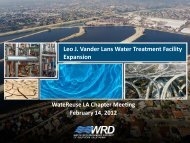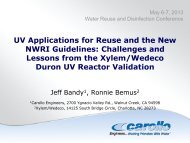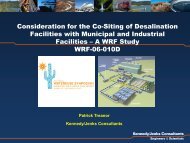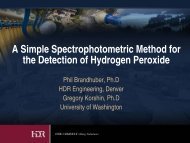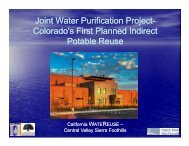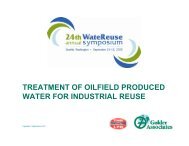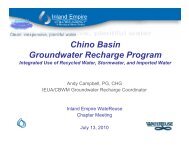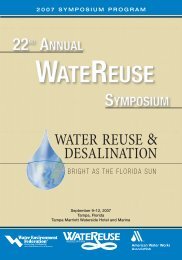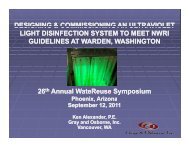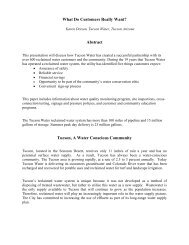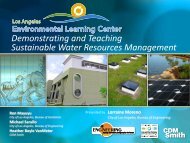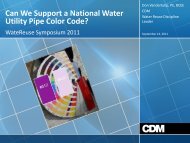Desalination of Golf Irrigation Water
Desalination of Golf Irrigation Water
Desalination of Golf Irrigation Water
You also want an ePaper? Increase the reach of your titles
YUMPU automatically turns print PDFs into web optimized ePapers that Google loves.
Typical 150 Acre <strong>Golf</strong> Course Uses About 200<br />
Million Gallons per Year
Each Course Uses the Equivalent <strong>Water</strong><br />
Annually as 1,800 Residential Units at 300 gpd
50 Championship <strong>Golf</strong> Courses in Orange<br />
County, CA Use About 10 BG or 30,000 AF/yr<br />
200 MG/yr * 50 Courses<br />
= 10,000,000,000 gal/yr<br />
Equivalent to 10% <strong>of</strong><br />
Nevada’s water allotment<br />
from the Colorado River
60% or 30 <strong>of</strong> 50 Orange County, CA Courses Use<br />
Recycled or Non-Potable Groundwater<br />
Why<br />
1. It is mandated, especially during drought condition<br />
2. It costs less, 50-90% <strong>of</strong> potable cost<br />
3. It is the right thing to do environmentally
Three Benefits to Using Recycled <strong>Water</strong> for <strong>Golf</strong><br />
Course <strong>Irrigation</strong>:<br />
1. It feels like the right thing to do (and accepted by<br />
public as completely safe in OC)<br />
2. More reliable supply<br />
3. Reduces/eliminates fertilizers
Two Problems with Using Recycled <strong>Water</strong> for<br />
<strong>Golf</strong> Course <strong>Irrigation</strong>:<br />
Problem 1 <strong>of</strong> 2:<br />
Impoundment storage can increase adjusted SAR and<br />
dissolved manganese due to excess algae
Sodium Adsorption Ratio (SAR) is Indicator <strong>of</strong> Soil<br />
Damage from Sodium<br />
1. SAR is common ratio presented which compares equivalents <strong>of</strong><br />
sodium versus calcium/magnesium<br />
2. Adjusted SAR takes into account availability <strong>of</strong> calcium – dependent<br />
on pH and alkalinity<br />
3. Lower pH makes calcium more available (free in solution) and frees<br />
up nutrients in solution for the plant to obtain
Recycled <strong>Water</strong> Has High Nutrients, Causing High<br />
Algae, pH Increases, Which Hurts SAR<br />
1) 2 H 2 O + LIGHT -> 2H 2 + O 2<br />
2) 2 H 2 + CO 2 -> [CH 2 O] + H 2 O<br />
3) 2 HCO<br />
-<br />
3 -> CO 2 + CO<br />
--<br />
3 + H 2 O<br />
4) CO<br />
--<br />
3 + H 2 O -> CO 2 + 2OH -<br />
Alkalinity does not change but pH increases & CaCO3 precipitates
Mang (mg/L)<br />
Periodic Low Oxygen Can Cause Manganese >0.2<br />
mg/L, and Iron Deficiency Could Occur<br />
Manganese Concentrations<br />
0.6<br />
0.5<br />
Rattle Mn<br />
UOR Top Mn<br />
UOR Bottom Mn<br />
0.4<br />
0.3<br />
0.2<br />
0.1<br />
0<br />
12/3/2009 1/22/2010 3/13/2010 5/2/2010 6/21/2010 8/10/2010 9/29/2010 11/18/2010 1/7/2011 2/26/2011<br />
Date
Two Problems with Using Recycled <strong>Water</strong> for<br />
<strong>Golf</strong> Course <strong>Irrigation</strong>:<br />
Problem 2 <strong>of</strong> 2:<br />
High salt including sodium and chloride, and impurities<br />
boron and ammonia can harm turf/soil
Higher Salt and Impurities Leads to the Following:<br />
1. Higher leaching fraction needed to flush concentrated salts,<br />
causing higher water cost and wet playing conditions<br />
Turf Grass Species Salt Tolerance soil extract EC limit soil extract [TDS] limit<br />
Poa Annua sensitive < 3 mS/cm < 2,000 mg/L<br />
Bentgrass sensitive < 3 mS/cm < 2,000 mg/L<br />
Perennial Ryegrass moderately tolerant 6 - 10 mS/cm 3,800 - 6,400 mg/L<br />
Kikuyu moderately tolerant 6 - 10 mS/cm 3,800 - 6,400 mg/L<br />
Bermuda tolerant > 10 mS/cm > 6,400 mg/L
Higher Salt and Impurities Leads to the Following:<br />
1. Higher leaching fraction needed to flush concentrated salts,<br />
causing higher water cost and wet playing conditions<br />
Turf Grass Species Salt Tolerance soil extract EC limit soil extract [TDS] limit<br />
Poa Annua sensitive < 3 mS/cm < 2,000 mg/L<br />
Bentgrass sensitive < 3 mS/cm < 2,000 mg/L<br />
Perennial Ryegrass moderately tolerant 6 - 10 mS/cm 3,800 - 6,400 mg/L<br />
Kikuyu moderately tolerant 6 - 10 mS/cm 3,800 - 6,400 mg/L<br />
Bermuda tolerant > 10 mS/cm > 6,400 mg/L<br />
2. Higher quantities <strong>of</strong> soil amendments such as gypsum and<br />
herbicides needed to maintain healthy turf<br />
3. Increased aerification and sand top-dressing needed to<br />
maintain soil permeability
<strong>Golf</strong>ers Desire Firm and Fast Conditions, Which<br />
is Impossible with Heavy Leaching
To Avoid Heavy Leaching and Soil Destruction from<br />
High Sodium, <strong>Golf</strong> Courses Using RO <strong>Desalination</strong>
USA <strong>Golf</strong> Courses Using RO <strong>Desalination</strong> on<br />
Recycled/Non-Potable <strong>Golf</strong> <strong>Irrigation</strong> <strong>Water</strong><br />
1. California’s Monterey Peninsula courses including Pebble<br />
Beach, Spyglass, Spanish Bay<br />
2. Florida Country Club Courses Seminole, Everglades, Osceola<br />
3. Arizona’s Scottsdale <strong>Water</strong> Campus feeds partially desalinated<br />
water to 23 golf courses
Study Looks at Three <strong>Golf</strong> Courses in Orange County,<br />
CA for Economics <strong>of</strong> <strong>Irrigation</strong> <strong>Desalination</strong><br />
1. Course maintenance is challenged from high salts and impurities<br />
Course <strong>Water</strong> Type Average [TDS] Average [Na+] Average [Cl-]<br />
A Non-Potable<br />
650 140 150<br />
Groundwater<br />
B Recycled <strong>Water</strong> 1,110 162 200<br />
C Recycled <strong>Water</strong> 870 150 206<br />
2. Brine disposal is available through direct or indirect ocean outfall<br />
3. Land, power, and membership desire is present
Course C Existing <strong>Water</strong> Use: ET + Leaching Fraction to<br />
Reduce Salt Concentration in Soils<br />
0 1a 6 7 8 9 10 11 12 13<br />
Adjusted<br />
Leaching<br />
<strong>Water</strong><br />
Total<br />
<strong>Irrigation</strong><br />
<strong>Water</strong><br />
Course<br />
Location Area<br />
<strong>Irrigation</strong> Vol<br />
Per Year<br />
Leaching<br />
Quantity<br />
Leaching<br />
Quantity<br />
# <strong>of</strong> Leaches<br />
per Year<br />
Leaching<br />
<strong>Water</strong><br />
%<br />
Leaching<br />
(ft^2) (gallons) (in/leach) (gallons) (gallons) (gallons) (gallons)<br />
Greens 110,000 2,700,000 6 410,000 32 13,100,000 11,900,000 14,600,000 81.5<br />
Fairways, 6,424,000 80,100,000 1.25 2,500,000 32 80,000,000 45,700,000 125,800,000 36.3<br />
Tees,<br />
Roughs,<br />
Non-Green<br />
60,100,000 1.25 2,500,000 32 80,000,000 54,200,000 114,300,000 47.4<br />
Total 143,000,000 111,800,000 254,800,000 43.9
Course C: Analysis <strong>of</strong> Salt Concentration with 0.42<br />
Leaching (Existing Conditions – No Desal)<br />
[TDS] [TDS] [TDS] [TDS]<br />
Applied <strong>Water</strong> Applied <strong>Water</strong> Bottom Root Zone Bottom Root Zone<br />
(meq/L) (mg/L) (meq/L) (mg/L)<br />
[Ca] 2.5 50 6.0 120<br />
[Mg] 1.2 15 2.9 35<br />
[Na] 6.5 149 15.5 356<br />
[K] 2.6 102 6.2 242<br />
[Cl] 5.9 209 14.1 499<br />
[CO3] 0.66 20 0.3 8<br />
[HCO3] 2.33 142 6.9 420<br />
[SO4] 3.9 187 9.3 446<br />
874 2,126<br />
EC = 3,300
Existing Average Annual Operation and Maintenance<br />
Cost <strong>of</strong> Courses A, B, and C
Course C: With Desal Leaching Fraction Decreases<br />
from 0.42 to 0.14 (28% water reduction)<br />
1. Same soil salt concentrations achieved with lower leaching<br />
fraction, course firm/fast with higher value (not included in analysis)<br />
2. RO will have about 15% waste reject, for net water savings <strong>of</strong> 13%<br />
(28% - 15%). <strong>Irrigation</strong> pumping power savings will be 28%<br />
• Soil enhancement gypsum reduced from 4,000 lb/day to 500 lb/day<br />
4. $30K/yr savings in herbicides and $8K/yr savings in top-dressing<br />
5. Labor savings not included at this time
Proposed Annual Operation and Maintenance Cost <strong>of</strong><br />
Courses A, B, and C with <strong>Desalination</strong>
Proposed Average Annual Operation and<br />
Maintenance Cost <strong>of</strong> RO System
Proposed Average Annual Operation and<br />
Maintenance Cost <strong>of</strong> RO System<br />
ASSUMPTIONS<br />
• Pre-treatment antiscalant (2 ppm) & acid (20 ppm)<br />
• Post-treatment gypsum (100 ppm) and base (20 ppm)<br />
• 13 week cartridge filter replacement<br />
• 3 year UF and RO membrane replacement<br />
• 225 psig total pumping not including irrigation pumps<br />
• 1 man-hour per day at $35/hour<br />
• $0.0015/gallon waste brine disposal fee<br />
• $12,000/yr misc repair/replacement
Proposed On-Site Capital Cost including Installation<br />
for Typical Recycled <strong>Water</strong> RO System<br />
400 gpm RO <strong>Desalination</strong> System Capital Cost<br />
RO Skid System $ 375,000<br />
Pretreatment Skid System $ 320,000<br />
Mechanical Equip & Install $ 199,250<br />
Civil Works* $ 148,750<br />
Electrical Equip & Install $ 218,000<br />
Engineering $ 70,000<br />
Contractor Overhead $ 189,150<br />
Contingency $ 126,100<br />
$ 1,650,000<br />
* - does not include building or fencing<br />
NOTE: 20 year capital repayment on $1.65M equals $135K/yr at 5%<br />
discount, equal to about 10% extra O&M cost per year
RO <strong>Desalination</strong> May Be Used to Reduce High Boron<br />
and Ammonia to Protect Cool Season Turf Grass
Conclusions<br />
1. If brine disposal is feasible, operating costs for RO are <strong>of</strong>fset<br />
2. Repayment <strong>of</strong> capital cost increases the annual O&M 10%<br />
3. This assumes no savings in labor, 20% reduced labor would<br />
<strong>of</strong>fset the capital<br />
4. Extra foursome/day at $100/round
Systems Described Under Construction<br />
Additional data will be collected<br />
over the next two years for<br />
future presentation, including<br />
one full scale and one pilot<br />
system operated on one green
For more information, or questions/<br />
comments, please contact<br />
Andy Komor, MS, PE<br />
andy@pacewater.com<br />
714-481-7225<br />
www.pacewater.com



